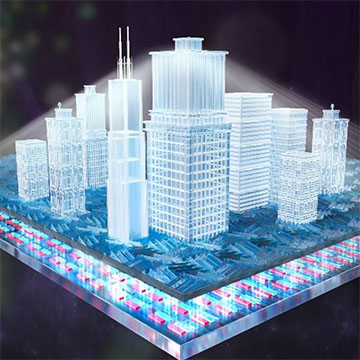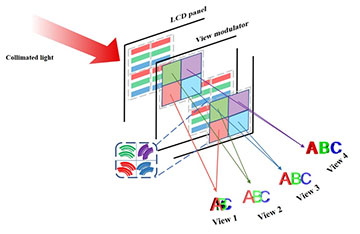
A new glasses-free 3D light field display system with a significantly extended viewing distance represents an important step toward compact, realistic-looking 3D displays that could be used for televisions, portable electronics and table-top devices. [Image: W. Qiao, Soochow University]
Beginning with early attempts such as the stereoscope in the 1830s, scientists have pursued the development of display technologies capable of truly reconstructing the 3D world around us. However, even centuries later, the majority of display devices only show 2D flat images that lack depth information.
Now, researchers in China report on a glasses-free vector light-field display that could help bring compact, full-color 3D realism to televisions, portable electronics and table-top devices (Optica, doi: 10.1364/OPTICA.439613). Such 3D displays typically suffer from a limited viewing range, but the team’s prototype system leverages a new type of flat lens to better preserve the image quality from further distances.
The feeling of reality
In light of the COVID-19 pandemic, Wen Qiao and her colleagues aimed to build teleconferencing technology that more closely mimics in-person meetings. They decided to design a multiview 3D display that discretizes the light field into spaced views to provide a 3D stereoscopic experience for multiple observers simultaneously without the need for special eyeglasses.
“Glasses-free 3D display is the key component that reconstructs the virtual scene and the feeling of reality,” says study author Qiao from Soochow University in China. “[But] the main issues in glasses-free 3D display include visual fatigue, limited motion parallax, limited viewing distance and a tradeoff between resolution and viewing angle.”
One approach to address the issue of viewing distance is incorporating diffractive optics, which can significantly increase the depth of focus (DOF). To this end, the researchers created a vector light-field display based on a diffractive flat lens that can reconstruct a 3D virtual image at multiple views with correct depth information.
Sawtooth microstructures
The researchers designed the lens with an optimized, circular sawtooth relief profile, and fabricated it by patterning the corresponding microstructures onto a flat surface. In the device, multiple intertwined lenses combine to form a so-called view modulator, an optical component that creates the various perspectives for a scene in a vector light-field display.
The device sends collimated LED light to uniformly illuminate an off-the-shelf LCD display panel, which is used to generate a refreshable image. The modulated light passes through a color filter and then through the view modulator. The sawtooth microstructures of the flat lenses that make up the view modulator then redirect the emergent light to the corresponding view.
“The corresponding surface-relief structures on the view modulator reveal the phase delay between adjacent pixels and reconstruct the sectional phase of 3D scene for the sampled views of light field,” says Qiao. “From the perspective of each view, the pixelated structures focus light beams to the view and work as a focusing lens.”
In the team’s design, diffractive flat lenses are intertwined to create a pixelated view modulator. A 3D display that creates four views, such as the one shown here, would incorporate four of these lenses, each converging the light into a unique view. [Image: W. Qiao, Soochow University] [Enlarge image]
Prototype results
The researchers built a 4-inch prototype where the viewing distance ranged from 24 to 90 cm with a 1.8 × 104-fold enhancement of the DOF. It exhibited a light efficiency of 82%—a value much higher than in other 3D displays of its kind. The display also demonstrated good image quality, with a smooth horizontal parallax and crosstalk below 26% over all viewing distances.
For future work, Qiao and her colleagues plan to improve the viewing angle, which is limited to only 9 degrees in the prototype, as well as the light efficiency with more sophisticated design algorithms.

